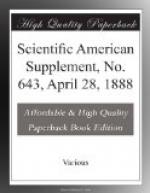Carbonic oxide, like oxygen, combined with haemoglobin, produced a comparatively stable compound; at any rate, a compound so stable that it ceased to be the efficient oxygen carrier of normal haemoglobin. This interference with the ordinary action of haemoglobin constituted poisoning by carbonic oxide. In connection with this subject the lecturer referred to the use of the spectroscope as an analytical agent, and showed the audience the spectrum of blood extracted from the hat of the late Mr. Briggs (for the murder of whom Muller was executed), and this was the first case in which the spectroscopic appearances of blood formed the subject matter of evidence. The third illustration of poisoning was poisoning by strychnine. Here again the power of the drug for undergoing oxidation was illustrated. It was noted that although our knowledge of the precise modus operandi of the poison was imperfect, nevertheless that the coincidence of the first fit in the animal after its exhibition with the formation of reduced haemoglobin in the body was important.
There followed upon this view of the chemical action of poison in the living body this question: Given a knowledge of certain properties of the elements—for example, their atomic weights, their relative position according to the periodic law, their spectroscopic character, and so forth—or given a knowledge of the molecular constitution, together with the general physical and chemical properties of compounds—in other words, given such knowledge of the element or compound as may be learned in a laboratory—does




